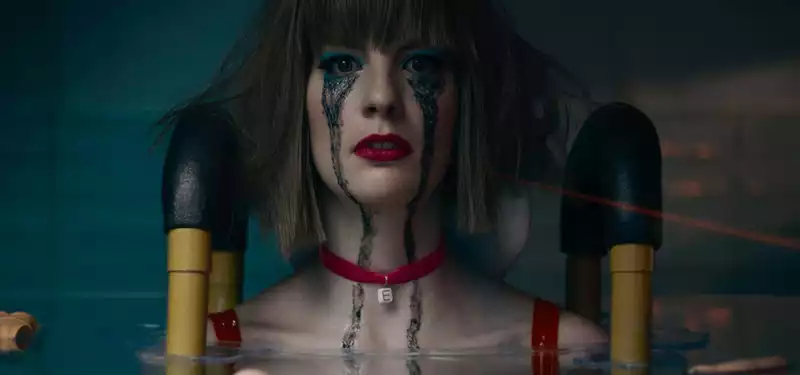Oct 9, 2023
2024 Oscar Nominee for Best Short Film: "Elektra" by Daria Kashcheva
Welcome to Cartoon Brew's spotlight series highlighting animated short films that have qualified for the 2024 Academy Awards. There are several ways for a film to qualify for an award. In this edition, we will focus on films that have won an Oscar-eligible award at a festival that is eligible for the Academy Awards.
Today's film is Czech filmmaker Daria Kasheva's Electra, who was previously nominated for an Academy Award for Best Animated Short Film for her 2019 film Daughter. Electra won Best Short Film at the Toronto International Film Festival and qualified for the Academy Award over other animation and live action competition.
"Elektra" is told from the first-person perspective of the adult protagonist, who recalls her tenth birthday and the lasting trauma it caused. Her memories are intertwined with dreams and imagination, and are presented through a mixture of animation techniques, including stop-motion and pixelation. A complicated parent-child relationship is implied, and Elektra may be an unreliable narrator of the facts of her youth, but there is no doubt that her pain is real.
Cartoon Brew: Your stop-motion film "Daughter" was an incredible success. With "Elektra," you added other animation techniques. What made you decide to make "Elektra" a multimedia film? To answer this question, I would have to start with "Daughter," which was a visual compromise and a creative solution to budget constraints. I wanted to work in stop motion. I am not much of a painter, and I don't enjoy it. I like to touch things, work with my hands, work with cameras and light. The solution was to use the cheapest materials for the design: wood and toilet paper. Toilet paper was easy to steal from the school bathroom, and given the second film, I understood that it would be easy to come up with a reasonable budget, so I didn't worry too much when writing the script. I also wanted to work with actors on a daily basis, using real props and spaces. I thought that would resonate better than puppets. The development of "Elektra" began with a willingness to explore what could be done in animation with the human body, combining live action and pixelation. When the story became about puberty, the human body, and sexuality, the "perfect" proportions of the Barbie doll gave me the idea to work with dolls.
What part of the story and concept resonated with you that made you take on the role of director? When I thought about why my character was lonely, I thought she was afraid of real relationships. That resonated with me. For a long time, I was the type of person who wanted to escape into a fantasy world, and over the course of a year I wrote dozens of drafts of the script, each time developing a completely different idea than the last. Eventually I came across a book called Electra: The Myth of Women Traced through the Western Imagination by Nancy Cater. From this book came the idea of a lonely Electra, rebelling against her mother and searching for the father who abandoned her as a child. She feels inadequate, isolated in her Barbie doll world, and always remembering her father's last message to be a "good girl." Another main influence was talking to psychotherapist Karel Malimanek, who consulted on the script. He told me that psychotherapy is never a linear process, but rather a process that takes years, in which the patient confuses past and present, dreams and reality. One might have lived their whole life believing that their tenth birthday was going to be okay. Then one day they realize that it is not so good and that something repressed was wrong. That influenced the structure of the film.
What did you learn about the production aspect, the filmmaking aspect, creativity, or the subject matter through your experience making this film? The most important skill for a director is communication, and I learned not only the ability to explain my vision, but also how to communicate when problems arise. It is vital to remain calm, to forget about ego and mood, to think about the film and the solution to the problem. I am impulsive, but acting impulsively never solves problems. Another important lesson was how to take care of the mental and physical health of the team. We often push hard, especially in the animation world, but it is a long process and it is very easy to get sick or burn out.
Sets, props, costumes, and makeup are all symbolic in some way. Emotional and psychological meanings are expressed in the design. I could explain them all, but I like to let the viewer use their imagination to interpret them. For example, the "do not enter" room is rooted in Freud's psychoanalytic theory, in which he often compared our psyche to a house. The rooms we spend time in, the rooms we show off to visitors, the rooms we flaunt to the world with their big windows. And then there is the room in the house that is often locked and that no one, not even ourselves, prefers to enter. Freud compares this room to the part of the subconscious where we store our fears, unpleasant desires, unacceptable wishes, and memories we would rather forget. For Elektra, entering that room is the last option. Every detail of the film was created to express Electra's feelings, not just as an interesting design. It is like a dream or a nightmare: if we try to find meaning in the details, we may understand ourselves better.
.



Post your comment